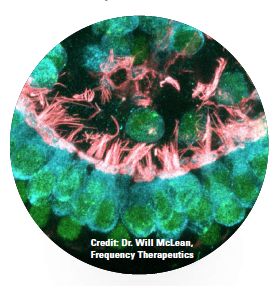Regenerative Medicine Research Tackles Hearing Loss
 Chris Loose, Ph.D., Co-founder and Chief Scientific Officer at Frequency Therapeutics, talks about his company’s efforts to develop a small molecule therapy to restore hearing.
Chris Loose, Ph.D., Co-founder and Chief Scientific Officer at Frequency Therapeutics, talks about his company’s efforts to develop a small molecule therapy to restore hearing.
Hearing loss is usually the result of inner ear or nerve damage. Aging and chronic exposure to loud noises can contribute to hearing loss. Congenital defects, injury, disease, or certain medications can also contribute to hearing impairment.
Within the inner ear, there are tiny sensory cells, called hair cells, that move in response to sound waves. These hair cells are necessary to convert the mechanical stimulus into nerve impulses. People are born with only 15,000 of these hair cells. If these hair cells die or are damaged in any way, hearing is lost. This loss of hearing is considered irreversible, with the only current options available for patients being hearing aids and surgical implants. There are currently no therapies to treat hearing loss.
That could change, however. Researchers at Frequency Therapeutics are working to develop a new therapeutic using small molecules that aim to restore hair cells in the inner ear and ultimately restore hearing. Frequency is researching a way to restore hearing by harnessing the regenerative potential of progenitor cells. Progenitor cells can differentiate into defined types of cells, and they are more restricted than stem cells. These cells, however, only divide under certain conditions, such as during fetal development. Frequency has developed a proprietary process to trigger the cells to grow and create new hair cells. It is expected that the therapy can be administered by direct injection into the middle ear where it crosses the round window membrane to enter the cochlea.
 The founders of Frequency, alongside Robert Langer, Sc.D., and Jeff Karp, Ph.D., uncovered pathways that already exist in nature and are applying their findings to drive cellular regeneration.
The founders of Frequency, alongside Robert Langer, Sc.D., and Jeff Karp, Ph.D., uncovered pathways that already exist in nature and are applying their findings to drive cellular regeneration.
“They found that the neighboring cells around the progenitors control communication and they send signals to tell the progenitors what to do," says Chris Loose, Ph.D., co-founder and chief scientific officer at Frequency Therapeutics. “Dr. Langer and Dr. Karp discovered a way to replace the natural messages with drugs that can tell the progenitors to grow or not grow, which can help restore healthy tissue structure and function. We can initiate the cues to innate progenitor stem cells to tell them when and how to repair tissue in the body."
The company’s proprietary platform, called Progenitor Cell Activation (PCA), focuses on Lgr5+ progenitor cells, instructing them to divide and differentiate, much like what is seen in naturally regenerating tissues such as the skin and intestine. This process has the potential to lead to a new category of therapeutics for degenerative conditions. Frequency’s initial focus is on chronic noise-induced hearing loss.
Other potential applications include skin disorders, muscle regeneration, and gastrointestinal diseases.
“What was really intriguing to us is that other species, such as birds and reptiles, are able to regenerate these cells to restore their own hearing," he explains.
Dr. Loose says research has found that there are native progenitors in the cochlea that give rise to these hair cells that are sitting in a dormant state.
“The company’s technology gives those progenitors the instruction to reactivate and reform new hair cells just like they did during development," he says.
In February, a number of the company’s co-founders published a paper in Cell Reports that provides the foundation for the company’s research. The research team, which included collaborators from Harvard Medical School, the Massachusetts Eye and Ear Infirmary, Massachusetts Institute of Technology (MIT) and Brigham and Women’s Hospital, first focused on optimizing the expansion of Lgr5 expressing cochlear progenitor cells. With the combination of a GSK3 inhibitor to activate the Wnt signaling pathway and a histone deacetylase (HDAC) inhibitor to activate gene transcription, the research team achieved more than 2,000-fold expansion of cochlear supporting cells compared with previous approaches.
The generation of new hair cells was achieved even in cochlear tissue that had been depleted of hair cells by exposure to an ototoxic antibiotic. Importantly, hair cells produced from the protocols exhibited the same physical features, gene expression, and functionality as typical cochlear hair cells.
In April 2017, Frequency received a $32 million Series A financing.
Frequency plans to begin clinical trials in 2018. Studies in mouse and human tissue have shown that the company’s drug candidate is able to create new hair cells. (PV)
~~~~~~~~~~~~~~~~~~~~~~~~~
About Chronic Hearing Loss
Most hearing deficits result from the loss of key cells in the inner ear, called sensory hair cells, which are necessary to convert sound waves into nerve impulses. In adult mammals, unlike birds or reptiles, these cells do not spontaneously regenerate, although progenitor cells capable of regenerating hair cells remain present in the ear.
Chronic noise induced hearing loss is a significant unmet need with no therapeutic approved for the condition. Around 48 million people are affected in the United States alone and the WHO estimates that 1.1 billion people are at risk for hearing loss from recreational noise alone. Untreated hearing loss in working-age adults costs the United States more than $56 billion in annual productivity.
Every day loud noises such as a busy subway, weekend concerts, and even the use of headphones can have a large impact on hearing.



















